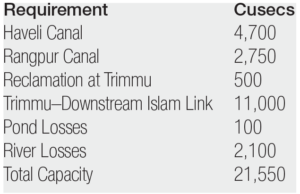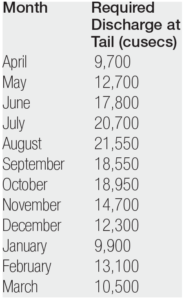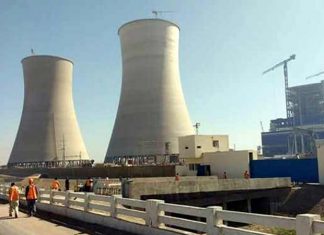The Indus Water Treaty (IWT) of 1960 was a watershed agreement that divided the Indus River basin between India and Pakistan. Under its terms, Pakistan relinquished claims to the three eastern rivers (Ravi, Beas, Sutlej) in exchange for the three western rivers (Indus, Jhelum, Chenab).
To mitigate the impact of losing the eastern rivers, Pakistan undertook a massive infrastructure project to transfer water from the western rivers to canal systems that had historically depended on the eastern rivers.
The Chashma Jhelum (C.J.) Link Canal, designed to divert water from the Indus River to the Jhelum River, has since become a major point of contention between the provinces of Sindh and Punjab.
The Indus River and Partition
The Indus River, known locally as Sindhu, was not navigable for the British due to its risky nature. Instead, the colonial government dammed, canalized, and barraged the river for irrigation. The coastal communities of the Indus delta, who can be described as the true low riparian, suffered the most due to reduced freshwater flows and increased seawater intrusion.
In some areas of upper Sindh Indus water flows in the canals and then it also flows in the fields to remove high salt content. The high salt content water ends up in lower Sindh through drainage canals. Lower Sindh suffers from sea water intrusion and also from salty drainage water intrusion from upper Sindh. Following the Partition of India in 1947, the rivers were divided, with the three eastern rivers going to India and the western rivers to Pakistan. Pakistan surrendered rights to the eastern rivers to secure the western rivers. This necessitated further damming and barraging of the western rivers to divert water to canals previously fed by the eastern rivers through six interlinking canals.
The Indus Water Treaty and the C.J. Link Canal
The Indus Basin Development Fund Agreement, signed alongside the IWT, outlined the projects to transfer water from the western rivers to replace the eastern river supplies. The project’s objectives were to:
Transfer water from the western rivers (Indus, Jhelum, Chenab) to meet existing irrigation uses in Pakistan, which had previously depended on the eastern rivers (Ravi, Beas, Sutlej). This would release the whole flow of the three eastern rivers for irrigation developments in India.
- Provide substantial additional irrigation development in West Pakistan.
- Develop 300,000 KW of hydroelectric potential for West Pakistan.
- Make an important contribution of soil reclamation and drainage in West Pakistan by lowering ground water levels in water-logged and saline areas.
- Afford a measure of flood protection in West Pakistan.
 The C.J. Link Canal was specifically designed to supply water from the Indus to canals off-taking at Trimmu, compensating for the loss of the Sutlej River waters. The design capacity of the C.J. Link Canal was estimated at 21,550 cusecs to meet the requirements of the Haveli Canal, Rangpur Canal, reclamation efforts at Trimmu, the Trimmu–Downstream Islam Link, and account for pond and river losses.
The C.J. Link Canal was specifically designed to supply water from the Indus to canals off-taking at Trimmu, compensating for the loss of the Sutlej River waters. The design capacity of the C.J. Link Canal was estimated at 21,550 cusecs to meet the requirements of the Haveli Canal, Rangpur Canal, reclamation efforts at Trimmu, the Trimmu–Downstream Islam Link, and account for pond and river losses.
 The canal was designed for seasonal operation, with varying discharges throughout the year. Table 3 in the design report specifies the monthly discharge requirements:
The canal was designed for seasonal operation, with varying discharges throughout the year. Table 3 in the design report specifies the monthly discharge requirements:
Annual total volume: 11.10 million Acre Feet (MAF).
One cusec is a flow rate unit meaning one cubic foot of water flowing per second.
MAF stands for million-acre feet a unit of volume used to measure large quantity of water. One MAF of water is roughly equivalent to a flow of 500,000 sustained for 24 hours.(Chat-gpt)
Questions and Contentions
The central questions in the Sindh-Punjab water dispute revolve around the C.J. Link Canal: Was it constructed under the IWT implementation plan? Is it solely a flood canal, or can Punjab use it at will? Who decides when the canal opens and closes, and have these decisions been fair to Punjab?
Sindh considers the C.J. Link Canal a “flood canal” and refers to the 1945 water agreement between Sindh and Punjab, arguing that the canal was not constructed under the Indus Water Treaty. Conversely, Punjab refers to the 1960 Indus Water Treaty between India and
The operation of the C.J. Link has been affected by interprovincial water rivalries. The implementation of the treaty and its impact on Pakistan’s internal water distribution system highlight the challenges faced
1970: India Stopped Water in Ravi and Sutlej for canals after 10 years as per Treaty.
1971: Chashma Jhelum Link canal ready to replace flows in canal
1972: Indus Water Treaty Totally Ignored by Federal Government and Sindh Province.
Two accords were signed between Sindh and Punjab in 1972 and 1974 on when to use the Chashma Jhelum link canal.
These accords by itself were betrayal of 1960 I.W. Treaty between India and Pakistan. In 1973, Governor of Punjab, Ghulam Mustafa Khar, stated that the canal was constructed for continuous operation, countering the notion that it was merely a flood canal
As a result, from 1971 onwards Sindh Government’s permission was sought annually until 1985, a year of acute water shortage. Despite claims of Punjab acting unilaterally, the canal was opened in 1985 with the approval of the then Prime Minister of Pakistan, Muhammad Khan Junejo, and the acknowledgment of Sindh’s Chief Minister.
However, Mr Palejo claim that throughout the history of Pakistan, the policies of the Pakistan establishment, dominated by the Punjab elites and authorities has all along been to impose its peculiar hegemonic demands and decisions through autocratic means. From this point on there were two more phases:
1985-1991: Ad Hoc arrangement to open C.J Link
1991: The IRSA Accord formally known as the water Apportionment accord of 1991 is historic agreement amongPakistan four provinces to allocate the waters of the Indus River System fairly. The committee had five-members four from the provinces and one from the federal government.
1991- till now: Unfortunately, Chashma Jhelum link canal is run politically and not according to 1960 Indus Water Treaty.
The way forward
If Chashma Jhelum Link is part of Indus water treaty and was built with Indus basin development fund agreement, then it should be operated as per the spirit of the agreement, to compensate for the loss of Sutlej River, to canals off taking at Trimmu.

 The C.J. Link Canal was constructed under the IWT to replace water supplies from the eastern rivers. Its operation has been mired in interprovincial disputes, with Sindh viewing it as a flood canal and Punjab considering it essential for year-round irrigation.
The C.J. Link Canal was constructed under the IWT to replace water supplies from the eastern rivers. Its operation has been mired in interprovincial disputes, with Sindh viewing it as a flood canal and Punjab considering it essential for year-round irrigation.
The canal is a link canal between Indus and Jhelum to replace waters for canals that were being fed by Islam barrage on river Sutlej. The treaty tried to safeguard the interests of the farmers whose canal waters were going to be shut from Sutlej and Ravi going dry.
The working of C.J link is not based on the spirit and working of 1960 Indus water treaty but based on interprovincial water rivalries. Sindh is still stuck in 1945 water agreement between Punjab and Sindh. Punjab looks at 1960 Indus water treaty between India and Pakistan.
Resolving this conflict requires addressing the grievances of Sindh while acknowledging the treaty-backed necessity of the canal for Punjab’s irrigation needs. A cooperative, transparent, and equitable approach is essential to ensure sustainable water management and reduce tensions in the region.























